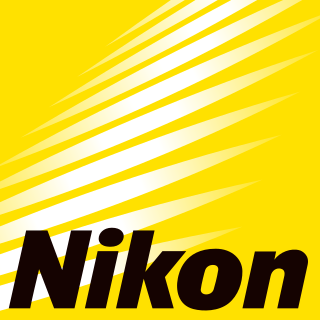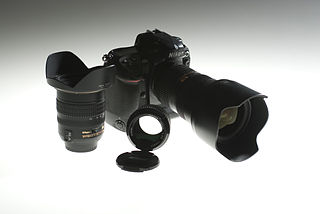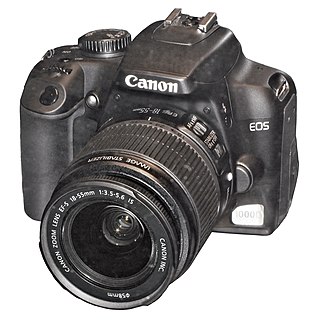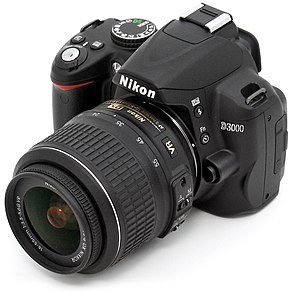
The Nikon D100 is a discontinued 6-megapixel digital single-lens reflex camera made by Nikon Corporation and designed as a consumer alternative to the professional D1 series cameras. It was the precursor of both the more advanced D70 and D200 cameras with the former continuing the consumer offerings and the latter beginning an advanced consumer and professional lineup. The D70 kept the controls which the D100 inherited from the F80 film camera, which has evolved into the current D7500 and D750 offerings, in cropped frame and full frame respectively. The D200 adopted the controls of the D1 series.

The Canon EOS 10D is a discontinued 6.3-megapixel semi-professional digital SLR camera, initially announced on 27 February 2003. It replaced the EOS D60, which is also a 6.3-megapixel digital SLR camera. It was succeeded by the EOS 20D in August 2004.

Nikon Corporation is an optics and photographic equipment manufacturer headquartered in Tokyo, Japan. The companies held by Nikon form the Nikon Group.

The Nikon D2X is a 12.4-megapixel professional digital single-lens reflex camera (DSLR) that Nikon Corporation announced on September 16, 2004. The D2X was the high-resolution flagship in Nikon's DSLR line until June 2006 when it was supplanted by the D2Xs and, in time, the Nikon D3 range, Nikon D4 range, the Nikon D5 and the Nikon D6— the latter four using a FX full-format sensor.

A digital single-lens reflex camera is a digital camera that combines the optics and mechanisms of a single-lens reflex camera with a solid-state image sensor and digitally records the images from the sensor.

The NikonD50 is a 6.1-megapixel entry-level digital single-lens reflex camera, sold from June 2005 until November 2006 by Nikon. It was Nikon's first DSLR aimed at the consumer market, and sold for US$899. It uses the Nikon F mount. The D50 is similar to the slightly older D70 using the same CCD sensor, with a slower maximum shutter speed and slightly smaller size; however, it continued to offer the internal focus motor of prior autofocus film and digital SLRs. Future entry-level Nikon DSLRs would eliminate the internal focus motor and require these motors to be in the lenses. Lack of a focus-motor in the camera eliminated the ability to autofocus with late film-era Nikkor AF and AF-D lenses, though these lenses work well on the D50.

The Nikon D200 is a 10.2-megapixel digital single-lens reflex camera that falls between entry-level/midrange DSLR cameras such as the Nikon D40, Nikon D40x, and D80 and high-end models such as the Nikon D2Hs and D2Xs. It was released by the Nikon Corporation in November 2005. The D200 was succeeded by the D300 in August 2007.

The Nikon D80 is a digital single-lens reflex camera model announced by Nikon on August 9, 2006. The camera shipped the first week of September to US retailers. Considered by many to be a hybrid of design elements of the entry-level D50 and high-end D200 cameras, it occupied the same price bracket the Nikon D70 did at the time of its release. It was replaced by the Nikon D90 in August 2008.

The Nikon D40 is a 6.1-megapixel DX format DSLR Nikon F-mount camera announced by Nikon on November 16, 2006. It replaces the D50 as Nikon's entry level DSLR. It features a 2.5-inch 230,000-dot resolution LCD monitor, CCD sensor with ISO 200-1600 and 3D Color Matrix Metering.

The Nikon D60 is a 10.2-megapixel Nikon F-mount digital single-lens reflex camera announced in January 2008. The D60 succeeds the entry-level Nikon D40x. It features the Nikon EXPEED image processor introduced in the higher-end Nikon D3 and D300.

Canon EOS 1000D is a 10.1-megapixel digital single-lens reflex camera announced by Canon on 10 June 2008 and started shipping in mid August 2008. It is known as the EOS Kiss F in Japan and the EOS Rebel XS in the United States and Canada. The 1000D is an entry-level DSLR that has been described as being a step below the 450D.

The Nikon D90 is a 12.3-megapixel digital single-lens reflex camera (DSLR) model announced by Nikon on August 27, 2008. It is a prosumer model that replaces the Nikon D80, fitting between the company's entry-level and professional DSLR models. It has a Nikon DX format crop sensor.

The Kodak Digital Camera System is a series of digital single-lens reflex cameras and digital camera backs that were released by Kodak in the 1990s and 2000s, and discontinued in 2005. They are all based on existing 35mm film SLRs from Nikon, Canon and Sigma. The range includes the original Kodak DCS, the first commercially available digital SLR.

The Nikon AF-S DX Nikkor 35mm f/1.8G is a lens manufactured by Nikon for use on Nikon DX format digital SLR cameras. It provides a field of view on a DX format camera similar to that of a normal lens on a 35mm film format camera.

The Nikon E series, co-developed with Fujifilm, are autofocus 1.3 megapixel professional grade quasi-full frame (35mm) Nikon F-mount digital single lens reflex cameras (DSLR) manufactured by Nikon since 1995.

The D5000 is a 12.3-megapixel DX-format DSLR Nikon F-mount camera, announced by Nikon on 14 April 2009. The D5000 has many features in common with the D90. It features a 2.7-inch 230,000-dot resolution tilt-and-swivel LCD monitor, live view, ISO 200–3200, 3D tracking Multi-CAM1000 11-point AF system, active D-Lighting system and automatic correction of lateral chromatic aberration. The D5000 seems to have been discontinued in November 2010.

The Nikon D3100 is a 14.2-megapixel DX format DSLR Nikon F-mount camera announced by Nikon on August 19, 2010. It replaced the D3000 as Nikon's entry level DSLR. It introduced Nikon's new EXPEED 2 image processor and was the first Nikon DSLR featuring full high-definition video recording with full-time autofocus and H.264 compression, instead of Motion JPEG compression. It was also the first Nikon DSLR to provide high-definition video recording at more than one frame rate.

The Nikon D5100 is a 16.2-megapixel DX-format DSLR F-mount camera announced by Nikon on April 5, 2011. It features the same 16.2-megapixel CMOS sensor as the D7000 with 14-bit depth, while delivering Full HD 1080p video mode at either 24, 25 or 30 fps. The D5100 is the first Nikon DSLR to offer 1080p video at a choice of frame rates; previous Nikon DSLRs that recorded 1080p only did so at 24 fps. It replaced the D5000 and was replaced by the D5200.

The Nikon D3200 is a 24.2-megapixel DX format DSLR Nikon F-mount camera officially launched by Nikon on April 19, 2012. It is marketed as an entry-level DSLR camera for beginners and experienced DSLR hobbyists who are ready for more advanced specs and performance.

The Nikon D5200 is an F-mount DSLR camera with a newly developed 24.1-megapixel DX-format CMOS image sensor first announced by Nikon on November 6, 2012 for most of the world and January 7, 2013 for the North American market.





















